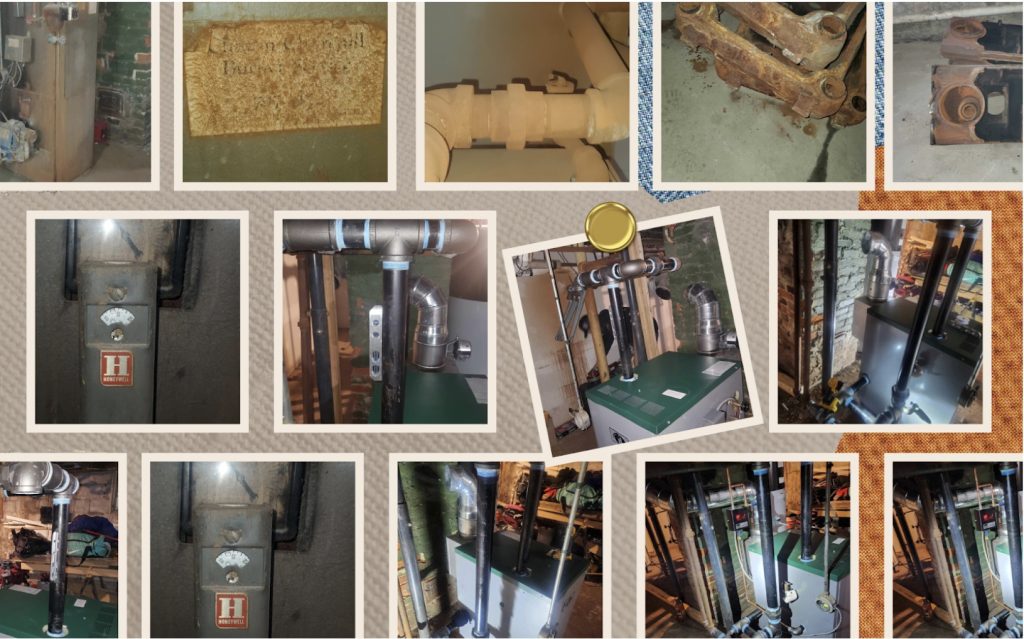Get Tech Tips
Subscribe to free tech tips.
Reviving History: Upgrading an 80-Year-Old Steam Boiler in Portland, Maine

This tech tip was written by Jennifer Manzo. Thanks, Jennifer!
As an HVAC technician in Maine, I've seen my fair share of aging systems, but nothing quite prepared me for the sight that greeted me while responding to a “no heat” call in a multi-family apartment building this winter. Stepping into the boiler room of a century-old building, I was met with a scene straight out of a time capsule—an 80-year-old steam boiler billowing a terrifying amount of steam into the dark basement.
My first instinct was to shut down the unit to prevent further damage. My initial thought was that the boiler itself had finally cracked, but upon further investigation, I found a literal hole in the supply union! While searching for the nameplate, I stumbled on something both awe-inspiring and concerning: this boiler had been faithfully serving the building since the 1940s without a Hartford Loop!
What is a Hartford Loop and why is it important?
A Hartford Loop is a simple but effective safety mechanism designed to prevent water from backing up into the boiler and causing catastrophic failure. We install a looped piping system between the header and the gravity return to balance the pressure of steam that supplies the radiators, as well as the condensed steam (water) fed back to the boiler.
In 1919, the Hartford Insurance and Boiler Inspection Company was facing a constant supply of heavily damaged—and even exploded—boilers, meaning claim after claim for replacement and injury. Realizing the majority of the problem was caused by the boilers “running dry,” their company invented the Hartford Loop, which has since become code throughout the US.
Realizing the significance of this find, I made a decision—it was time to retire this old boiler and usher in a new era of efficiency and safety. But it wasn't just about replacing a piece of equipment; it was about preserving history while embracing modern technology.
With the building owner's approval, we set to work on designing a new system. We really wanted to preserve as much of the piping system as possible, which meant doing a thorough inspection of the entire building's infrastructure, as well as testing the existing piping for any vulnerabilities or shortcomings. We came to find the original craftsmanship to be a work of art and, fortunately, were able to keep most of it! Minor replacements, all new valves and pumps, and the addition of the Hartford Loop were well underway.
Now it was time to put my expertise to the test. Sizing and choosing a new boiler to match the integrity, and soul that the original installer had poured into his work wasn't easy. I needed to ensure equal longevity and reliability using a more modern unit and as the saying goes, “They sure don’t make ‘em like they used to.” It was a labor-intensive process, requiring careful planning and precision installation, but the results were well worth it. I ended up choosing a Peerless Per63E—147k BTU, 4-section steam boiler. It was no doubt the right boiler for the job, but its physical size posed its own set of challenges.
Once the piping system was perfect, we slid the new boiler in place. Its platform was built for a much taller boiler, and the hundred-year-old floor was less than level, so we opted to lift the new one with concrete blocks and sheaves, then extended the upright out of the boiler to reach our new pipes. It’s important to note that though I had designed Hartford Loops in school and understood the concept completely, my hands had never physically built one before. You see, the Hartford Loop became law so long ago that this was the first project I’d taken on where one was not already present. My anxiety was plentiful as we designed and built this crucial part of our new system. The last step to this project was finally complete and all that was left to do was fire it up and get to commissioning!
As the new system hummed to life, I couldn't help but feel a sense of satisfaction. We had not only solved the immediate problem—heat for the beautiful family in apartment 1, but we had also safeguarded the building's future for years to come. In doing so, we paid homage to the legacy of the old boiler and the skilled hands that built it, ensuring that its memory would live on in the annals of HVAC history.
In the ever-evolving world of heating and cooling technology, it's easy to overlook the contributions of the past. But sometimes, it takes a visit from an 80-year-old boiler to remind us of the lessons learned and the innovations that have yet to come.
—Jennifer Manzo











Comments
To leave a comment, you need to log in.
Log In